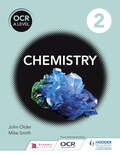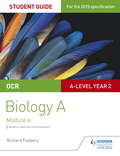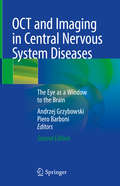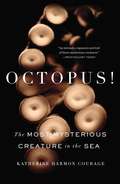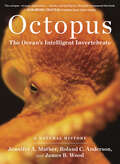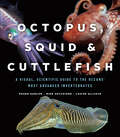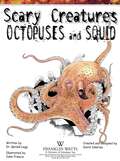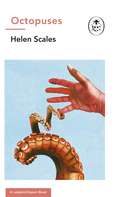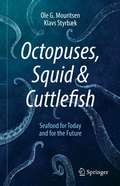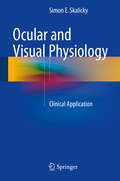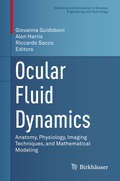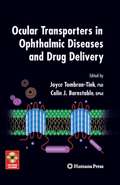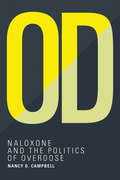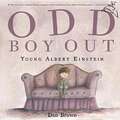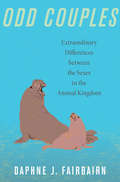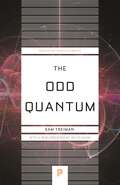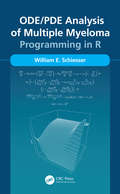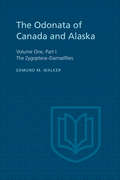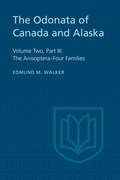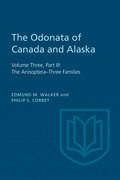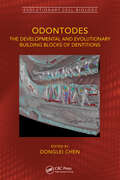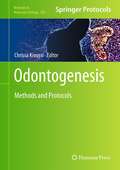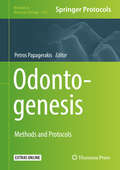- Table View
- List View
OCR A Level Chemistry Student Book 2
by Mike Smith John OlderThis is an OCR endorsed resource Stretch and challenge your students' knowledge and understanding of Chemistry, build their mathematical and practical skills, and provide plenty of assessment guidance with this OCR Year 2 Student Book.- Build understanding with a summary of prior knowledge and diagnostic questions at the start of each chapter to help bring students up to speed- Support practical assessment with Practical Skill summaries that help develop your students' knowledge and skills- Test understanding and provide plenty of practice to assess progression, with Test Yourself Questions and multiple choice questions- Provide mathematical support with examples of method integrated throughout and a dedicated 'Maths in Chemistry' chapter- Develop understanding with free online access to Test yourself Answers, an Extended Glossary, Learning Outcomes and Topic Summaries
OCR A Level Chemistry Student Book 2
by Mike Smith John OlderExam Board: OCRLevel: A-levelSubject: ChemistryFirst Teaching: September 2015First Exam: June 2017This is an OCR endorsed resource Stretch and challenge your students' knowledge and understanding of Chemistry, build their mathematical and practical skills, and provide plenty of assessment guidance with this OCR Year 2 Student Book.- Build understanding with a summary of prior knowledge and diagnostic questions at the start of each chapter to help bring students up to speed- Support practical assessment with Practical Skill summaries that help develop your students' knowledge and skills- Test understanding and provide plenty of practice to assess progression, with Test Yourself Questions and multiple choice questions- Provide mathematical support with examples of method integrated throughout and a dedicated 'Maths in Chemistry' chapter- Develop understanding with free online access to Test yourself Answers, an Extended Glossary, Learning Outcomes and Topic Summaries
OCR A Level Year 2 Biology A Student Guide: Module 6
by Richard FosberyWritten by experienced examiner Richard Fosbery, this Student Guide for Biology:-Identifies the key content you need to know with a concise summary of topics examined in the A-level specifications-Enables you to measure your understanding with exam tips and knowledge check questions, with answers at the end of the guide-Helps you to improve your exam technique with sample answers to exam-style questions- Develops your independent learning skills with content you can use for further study and research
OCT and Imaging in Central Nervous System Diseases: The Eye as a Window to the Brain
by Andrzej Grzybowski Piero BarboniThe second edition of OCT and Imaging in Central Nervous System Diseases offers updated state-of-the-art advances using optical coherence tomography (OCT) regrading neuronal loss within the retina. Detailed information on the OCT imaging and interpretation is provided for the evaluation of disease progression in numerous neurodegenerative disorders and as a biological marker of neuroaxonal injury. Covering disorders like multiple sclerosis, Parkinson’s disease, Alzheimer’s disease, intracranial hypertension, Friedreich’s ataxia, schizophrenia, hereditary optic neuropathies, glaucoma, and amblyopia, readers will given insights into effects on the retina and the and optic nerve. Individual chapters are also devoted to OCT technique, new OCT technology in neuro-ophthalmology, OCT and pharmacological treatment, and the use of OCT in animal models.Similar to the first edition, this book is an excellent and richly illustrated reference for diagnosis of many retinal diseases and monitoring of surgical and medical treatment. OCT allows to study vision from of the retina to the optic tracts. Retinal axons in the retinal nerve fiber layer (RNFL) are non-myelinated until they penetrate the lamina cribrosa. Hence, the RNFL is an ideal structure for visualization of any process of neurodegeneration, neuroprotection, or regeneration. By documenting the ability of OCT to provide key information on CNS diseases, this book illustrates convincingly that the eye is indeed the “window to the brain”.
Octopus!
by Katherine Harmon CourageNo one understands the octopus. With eight arms, three hearts, camouflaging skin, and a disarmingly sentient look behind its highly evolved eyes, how could it appear anything but utterly alien? Octopuses have been captivating humans for as long as we have been catching them. Many cultures have octopus-centric creation myths, art, and, of course, cuisine. For all of our ancient fascination and millions of dollars' worth of modern research, however, we still have not been able to get a firm grasp on these enigmatic creatures. Now, Katherine Harmon Courage, a veteran journalist and contributing editor for Scientific American, dives into the mystifying underwater world of the octopus. She reports from around the globe of her adventures in Spain, Greece, and even Brooklyn, inviting us to experience the scientific discoveries and deep cultural ties that connect us to the octopus. You'll discover: The oldest known fossilized octopus is estimated to have lived 296 million years ago--even before the first dinosaurs emerged. Government agencies are funding research labs around the world to re-create the octopus's naturally occurring camouflage techniques. About two thirds of an octopus's brain capacity is spread throughout its eight arms, meaning each one literally has a mind of its own. Octopuses have aced numerous intelligence tests, including opening childproof bottles, solving mazes, and even recognizing individual people. The octopus can change colors and textures within milliseconds to vanish against its background--yet we have no evidence that it can see in color. Courage deftly interweaves personal narrative with interviews with leading octopus experts. The result is an entertaining yet scientifically grounded exploration of the octopus and its infinitely complex world.
Octopus: The Ocean's Intelligent Invertebrate
by James B. Wood Roland C. Anderson Jennifer A. MatherThe visually arresting and often misunderstood octopus has long captured popular imagination. With an alien appearance and an uncanny intellect, this exceptional sea creature has inspired fear in famous lore and legends—from the giant octopus attack in 20,000 Leagues Under the Sea to Ursula the sea witch in The Little Mermaid. Yet its true nature is more wondrous still. After decades of research, the authors reveal a sensitive, curious, and playful animal with remarkable intelligence, an ability to defend itself with camouflage and jet propulsion, an intricate nervous system, and advanced problem-solving abilities. In this beautifully photographed book, three leading marine biologists bring readers face to face with these amazingly complex animals that have fascinated scientists for decades. From the molluscan ancestry of today’s octopus to its ingenious anatomy, amazing mating and predatory behaviors, and other-worldly relatives, the authors take readers through the astounding life cycle, uncovering the details of distinctive octopus personalities. With personal narratives, underwater research, stunning closeup photography, and thoughtful guidance for keeping octopuses in captivity, Octopus is the first comprehensive natural history of this smart denizen of the sea.
The Octopus Scientists (Scientists in the Field Series)
by Sy Montgomery Keith EllenbogenWith three hearts and blue blood, its gelatinous body unconstrained by jointed limbs or gravity, the octopus seems to be an alien, an inhabitant of another world. It's baggy, boneless body sprouts eight arms covered with thousands of suckers--suckers that can taste as well as feel. The octopus also has the powers of a superhero: it can shape-shift, change color, squirt ink, pour itself through the tiniest of openings, or jet away through the sea faster than a swimmer can follow. But most intriguing of all, octopuses--classed as mollusks, like clams--are remarkably intelligent with quirky personalities. This book, an inquiry into the mind of an intelligent invertebrate, is also a foray into our own unexplored planet. These thinking, feeling creatures can help readers experience and understand our world (and perhaps even life itself) in a new way.
Octopus, Squid, and Cuttlefish: A Visual, Scientific Guide to the Oceans’ Most Advanced Invertebrates
by Mike Vecchione Roger Hanlon Louise AllcockLargely shell-less relatives of clams and snails, the marine mollusks in the class Cephalopoda—Greek for “head-foot”—are colorful creatures of many-armed dexterity, often inky self-defense, and highly evolved cognition. They are capable of learning, of retaining information—and of rapid decision-making to avoid predators and find prey. They have eyes and senses rivaling those of vertebrates like birds and fishes, they morph texture and body shape, and they change color faster than a chameleon. In short, they captivate us. From the long-armed mimic octopus—able to imitate the appearance of swimming flounders and soles—to the aptly named flamboyant cuttlefish, whose undulating waves of color rival the graphic displays of any LCD screen, there are more than seven hundred species of cephalopod. Featuring a selection of species profiles, Octopus, Squid, and Cuttlefish reveals the evolution, anatomy, life history, behaviors, and relationships of these spellbinding animals. Their existence proves that intelligence can develop in very different ways: not only are cephalopods unusually large-brained invertebrates, they also carry two-thirds of their neurons in their arms. A treasure trove of scientific fact and visual explanation, this worldwide illustrated guide to cephalopods offers a comprehensive review of these fascinating and mysterious underwater invertebrates—from the lone hunting of the octopus, to the social squid, and the prismatic skin signaling of the cuttlefish.
Octopuses and Squid (Scary Creatures Series)
by Gerald Legg John FrancisDescribes the appearance and behavior of octopuses and squid and examines why they are frightening, also includes a fun world map of where octopus and squid species can be found.
Octopuses: A Ladybird Expert Book (The Ladybird Expert Series #32)
by Dr Helen ScalesPart of the ALL-NEW LADYBIRD EXPERT SERIES- Why is it octopuses, and not octopi or octopodes?- How did octopuses evolve to be so clever?- How can octopuses see and speak with their skin? EXAMINE these crafty hunters of the seabed - shape-shifting, skin-signalling and using complex tools - their remarkable abilities are still being uncovered.BENDY BODIES, BIG BRAINSWritten by celebrated marine biologist and documentarian Helen Scales, Octopuses is an enthralling introduction to these utterly unique creatures, the myths and fiction they have inspired, and what they can tell us about the roots of intelligence.
Octopuses, Squid & Cuttlefish: Seafood for Today and for the Future
by Ole G. Mouritsen Klavs StyrbækHumans everywhere have always been fascinated by octopuses, squid, and cuttlefish, known biologically as cephalopods. They evolved hundreds of millions of years ago and are related to molluscs such as mussels and snails. They can grow to an enormous size with eyes as big as footballs, but they still live for only a couple of years. They mate once in their lifetime and die shortly after. They have blue blood and three hearts and they can shoot out jet-black ink. They have a brain and have behaviours that could be interpreted as signs of intelligence, even though more than half of their brain is distributed in their arms. They are colour blind, but they can change the colour of their skin in a flash. They are masters of disguise and are able to alter the texture of their skin and the patterns displayed on it at lighting speed. They can also ‘taste’ using the suckers on their arms. They can move extremely fast thanks to a jet-propulsion system built into their body cavity. Although they are soft-bodied and look vulnerable, cephalopods are formidable predators. Octopuses have arms that are so strong that they can exert a force equal to hundreds of times their own body weight. Squid and cuttlefish can shoot out a tentacle to capture prey at the speed of a javelin thrown by an expert athlete. Cephalopods are, however, so much more than just fascinating creatures with strange physical characteristics. They are a nutritious, delicious protein source that has found a place for thousands of years in many food cultures around the world. As squid, cuttlefish, and octopuses are native to virtually all parts of the ocean, they are an excellent and available alternative to meat from terrestrial animals. This book is written to promote the overall place of cephalopods in home kitchens and to inspire the uninitiated to add them to their diet. It describes the many facets of their anatomy that play a central role in their potential use as healthy, diverse, and interesting food sources, with a particular emphasis on their taste and texture. By way of an assortment of recipes, the authors hope to dispel the myth that it is difficult to prepare delicious dishes using squid, cuttlefish, and octopuses. In addition, there are contributions to the on-going discussions about how marine resources can be exploited more responsibly in a sustainable manner. Ole G. Mouritsen is a professor of gastrophysics and culinary food innovation at the University of Copenhagen,president of the Danish Gastronomical Academy, and director of the Danish national research and communication centre Taste for Life. Klavs Styrbæk is a chef and leader of the gastronomic enterprise STYRBÆKS, which includes a gourmet restaurant, a cooking school, a catering service, and a product development branch.
Ocular and Visual Physiology
by Simon E. SkalickyThis book meets the growing demand among ophthalmologists, optometrists and orthoptists, in training and in practice, as well as visual neuroscientists, to have a clear, succinct and well-written textbook to objectively cover the subject of ocular and visual physiology. Ocular and visual physiology is a core knowledge component for these disciplines, and yet is often difficult to understand. However, this book clearly conveys the simple elegance of the relationship between structure and function that is the hallmark of understanding the physiology of the eye and visual system. Ocular and Visual Physiology - Clinical Application is essential reading for any one hoping to have a clear understanding of the subject. Students will find it a great resource to pass their exams. Each of the chapters has been independently reviewed and edited by an expert in the field with a clinical or visual scientific academic background. The text is based on the latest publications in peer-reviewed journals that are closely referenced within the body of the text.
Ocular Fluid Dynamics: Anatomy, Physiology, Imaging Techniques, and Mathematical Modeling (Modeling and Simulation in Science, Engineering and Technology)
by Giovanna Guidoboni Alon Harris Riccardo SaccoThe chapters in this contributed volume showcase current theoretical approaches in the modeling of ocular fluid dynamics in health and disease. By including chapters written by experts from a variety of fields, this volume will help foster a genuinely collaborative spirit between clinical and research scientists. It vividly illustrates the advantages of clinical and experimental methods, data-driven modeling, and physically-based modeling, while also detailing the limitations of each approach. Blood, aqueous humor, vitreous humor, tear film, and cerebrospinal fluid each have a section dedicated to their anatomy and physiology, pathological conditions, imaging techniques, and mathematical modeling. Because each fluid receives a thorough analysis from experts in their respective fields, this volume stands out among the existing ophthalmology literature.Ocular Fluid Dynamics is ideal for current and future graduate students in applied mathematics and ophthalmology who wish to explore the field by investigating open questions, experimental technologies, and mathematical models. It will also be a valuable resource for researchers in mathematics, engineering, physics, computer science, chemistry, ophthalmology, and more.
Ocular Transporters in Ophthalmic Diseases and Drug Delivery
by Colin J. Barnstable Joyce Tombran-TinkIn this exceptionally important new work, a panel of distinguished authors discusses all the latest developments in the study of ocular transporters. Focusing on the molecular characteristics, localization, and substrate specificities in various compartments of the eye, this volume discusses how transporters regulate the clarity of the cornea and lens, the movements of fluids across the ciliary epithelium and nutrients across the retinal pigment epithelium.
OD: Naloxone and the Politics of Overdose (Inside Technology)
by Nancy D. CampbellThe history of an unnatural disaster—drug overdose—and the emergence of naloxone as a social and technological solution.For years, drug overdose was unmentionable in polite society. OD was understood to be something that took place in dark alleys—an ugly death awaiting social deviants—neither scientifically nor clinically interesting. But over the last several years, overdose prevention has become the unlikely object of a social movement, powered by the miracle drug naloxone. In OD, Nancy Campbell charts the emergence of naloxone as a technological fix for overdose and describes the remaking of overdose into an experience recognized as common, predictable, patterned—and, above all, preventable. Naloxone, which made resuscitation, rescue, and “reversal” after an overdose possible, became a tool for shifting law, policy, clinical medicine, and science toward harm reduction. Liberated from emergency room protocols and distributed in take-home kits to non-medical professionals, it also became a tool of empowerment.After recounting the prehistory of naloxone—the early treatment of OD as a problem of poisoning, the development of nalorphine (naloxone's predecessor), the idea of “reanimatology”—Campbell describes how naloxone emerged as a tool of harm reduction. She reports on naloxone use in far-flung locations that include post-Thatcherite Britain, rural New Mexico, and cities and towns in Massachusetts. Drawing on interviews with approximately sixty advocates, drug users, former users, friends, families, witnesses, clinicians, and scientists—whom she calls the “protagonists” of her story—Campbell tells a story of saving lives amid the complex, difficult conditions of an unfolding unnatural disaster.
Odd Boy Out
by Don BrownWhen he was born, Albert was a peculiar, fat baby with an unusually big and misshaped head. When he was older, he hit his sister, bothered his teachers, and didn't have many friends. But in the midst of all of this, Albert was fascinated with s
Odd Couples: Extraordinary Differences between the Sexes in the Animal Kingdom
by Daphne J. FairbairnThe remarkable and unique ways that male and female animals play out gender roles in natureWhile we joke that men are from Mars and women are from Venus, our gender differences can't compare to those of many other animals. For instance, the male garden spider spontaneously dies after mating with a female more than fifty times his size. And male blanket octopuses employ a copulatory arm longer than their own bodies to mate with females that outweigh them by four orders of magnitude. Why do these gender gulfs exist?Introducing readers to important discoveries in animal behavior and evolution, Odd Couples explores some of the most extraordinary sexual differences in the animal world. Daphne Fairbairn uncovers the unique and bizarre characteristics of these remarkable species and the special strategies they use to maximize reproductive success. Fairbairn also considers humans and explains that although we are keenly aware of our own sexual differences, they are unexceptional within the vast animal world.Looking at some of the most amazing creatures on the planet, Odd Couples sheds astonishing light on what it means to be male or female in the animal kingdom.
The Odd Quantum (Princeton Science Library #141)
by Sam TreimanAn acclaimed physicist’s accessible yet rigorous introduction to quantum mechanics for nonspecialistsThis is a rare and much-needed book: a concise but comprehensive account of quantum mechanics for popular science readers written by a respected physicist. Sam Treiman—who was internationally renowned for his work in particle physics—makes quantum mechanics accessible to nonspecialists. Combining mastery of the material with clear, elegant prose and infectious enthusiasm, he conveys the substance, methods, and profound oddities of the field.Treiman begins with an overview of quantum mechanics. He sketches the early development of the field by Einstein, Bohr, Heisenberg, Schrödinger, and others, and he makes clear how the quantum outlook flies in the face of common sense. As he explains, the quantum world is intrinsically probabilistic. For example, a particle is not in general in some particular place at a given instant, nor does it have a definite momentum. According to the Heisenberg uncertainty principle, there is a limit to how well both location and momentum can be specified simultaneously. In addition, particles can move through barriers and otherwise move in regions of space that are forbidden by classical mechanics. If a particle has a choice of different paths, it pursues all of them at once. Particles display wave-like characteristics and waves show particle-like characteristics. Treiman pays special attention to the more fundamental wave outlook and its expression in quantum field theory. He deals here with the remarkable fact that all the particles of a given species are strictly identical, and with the unnerving fact that particles can be created and destroyed. As Treiman introduces us to these and other wonders, he also touches—without resolution—on some of the deep philosophical problems of quantum mechanics, notably how probabilities become facts.Weaving together impeccable science, engaging writing, and a talent for clear explanation honed over Treiman's distinguished career as a physicist and teacher, The Odd Quantum is a remarkable survey of a field that changed the course of modern scientific and philosophical thought.
ODE/PDE Analysis of Multiple Myeloma: Programming in R
by William E. SchiesserMultiple myeloma is a form of bone cancer. Specifically, it is a cancer of the plasma cells found in bone marrow (bone soft tissue). Normal plasma cells are an important part of the immune system. Mathematical models for multiple myeloma based on ordinary and partial differential equations (ODE/PDEs) are presented in this book, starting with a basic ODE model in Chapter 1, and concluding with a detailed ODE/PDE model in Chapter 4 that gives the spatiotemporal distribution of four dependent variable components in the bone marrow and peripheral blood: (1) protein produced by multiple myeloma cells, termed the M protein, (2) cytotoxic T lymphocytes (CTLs), (3) natural killer (NK) cells, and (4) regulatory T cells (Tregs). The computer-based implementation of the example models is presented through routines coded (programmed) in R, a quality, open-source scientific computing system that is readily available from the Internet. Formal mathematics is minimized, e.g., no theorems and proofs. Rather, the presentation is through detailed examples that the reader/researcher/analyst can execute on modest computers using the R routines that are available through a download. The PDE analysis is based on the method of lines (MOL), an established general algorithm for PDEs, implemented with finite differences.
The Odonata of Canada and Alaska: The Zygoptera–Damselflies
by Edmund WalkerDr. Walker makes a signal contribution in gathering together all available information on the dragonflies of Canada and Alaska. The order as a whole and the zygoptera are covered. The treatment is not confined to taxonomy and geographical distribution, but includes data on habitats, seasons of adult life, and brief notes on habits when these are available.
The Odonata of Canada and Alaska: The Anisoptera–Four Families
by Edmund WalkerDr. Walker makes a signal contribution in gathering together all available information on the dragonflies of Canada and Alaska. The order as a whole and the zygoptera are covered. The treatment is not confined to taxonomy and geographical distribution, but includes data on habitats, seasons of adult life, and brief notes on habits when these are available.
The Odonata of Canada and Alaska: The Anisoptera–Three Families
by Edmund Walker Philip CorbetDr. Walker and Dr. Corbet make a signal contribution in gathering together all available information on the dragonflies of Canada and Alaska. The order as a whole and the zygoptera are covered. The treatment is not confined to taxonomy and geographical distribution, but includes data on habitats, seasons of adult life, and brief notes on habits when these are available.
Odontodes: The Developmental and Evolutionary Building Blocks of Dentitions (Evolutionary Cell Biology)
by Donglei ChenThe odontode system, which encompasses teeth and other dentine-based structures, is ancient. Odontodes are present in the oldest vertebrate fossils, dating back 500 million years, and still play an important role in the anatomy and function of living jawed vertebrates. Fossils preserve odontode tissues with remarkable nanoscale fidelity, allowing the evolution and diversification of the odontode system to be studied in deep time as well as across the diversity of living vertebrates. This synthetic volume presents an overview of odontode research by internationally leading researchers from different fields of biology.. Key Features Summarizes classic and cutting-edge research devoted to the development and evolution Focuses on the cellular aspects of odontogenesis Documents the structural and functional diversity of odontode tissues Describes the patterning mechanisms of dentitions in various vertebrate groups Provides a thorough index for students
Odontogenesis
by Chrissa KioussiOnly in recent times has the possibility of growing and implanting replacement teeth, made from one's own cells, moved into the realm of realistic possibilities; however, the molecular and cellular mechanisms of tooth development must be studied in a range of vertebrates, from zebrafish to mice, so that evolutionarily conserved network kernels, which will define the cellular states of generic vertebrate tooth development, can be recognized. In Odontogenesis: Methods and Protocols, experts in the field examine techniques to approach this burgeoning field. This detailed volume includes chapters on the detection of "tooth development" gene expression, both at the RNA and protein level, current approaches to the manipulation of gene expression levels and subsequent analysis of tooth phenotypes, as well as chapters concerning current efforts to get living tooth implants working without waiting for a full understanding of the developmental pathways at the molecular level. Written in the highly successful Methods in Molecular BiologyTM series format, chapters include introductions to their respective topics, lists of the necessary materials and reagents, step-by-step, readily reproducible laboratory protocols, and tips for troubleshooting and avoiding known pitfalls. Practical and easy to use, Odontogenesis: Methods and Protocols aims to help researchers move forward toward the ultimate goal of getting a "bioengineered tooth" into the patient's mouth.
Odontogenesis: Methods and Protocols (Methods in Molecular Biology #1922)
by Petros PapagerakisThis volume provides methods and approaches to study genetic and environmental regulatory controls on odontogenesis. Chapters guide readers through protocols for isolation and characterization of both epithelial and mesenchymal dental cells, methods on isolation, phenotypic characterization, expansion, differentiation, immunofluorescence, in situ hybridization, immunohistochemistry, imaging protocols, rodent dental fluorosis model, 3D assessment of crown size, dental diseases models, next generation sequencing, genetic and epigenetic studies, genome-wide association studies as well as clinical protocols for measurement of early childhood caries and saliva, and supragingival fluids and biofilm collection and subsequent analyses. Written in the highly successful Methods in Molecular Biology series format, chapters include introductions to their respective topics, lists of the necessary materials and reagents, step-by-step, readily reproducible laboratory protocols, and tips on troubleshooting and avoiding known pitfalls. Authoritative and cutting-edge, Odontogenesis: Methods and Protocols aims to guide researchers towards elucidating the secrets and mysteries of a fascinating and unique organ, the tooth.
